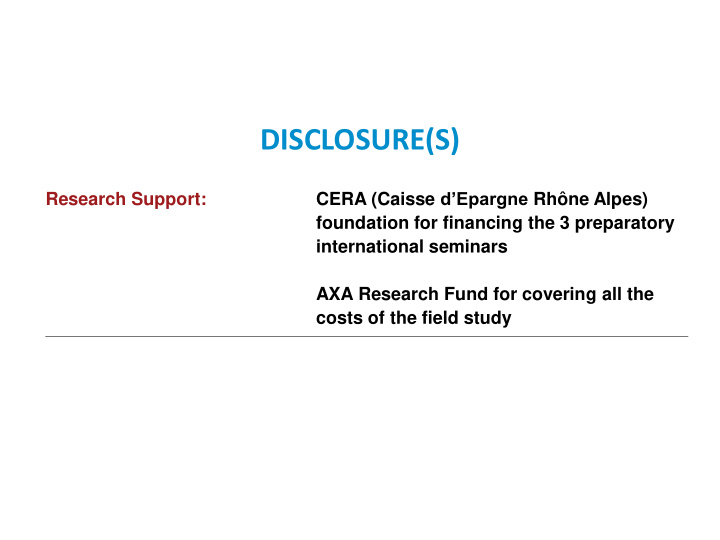



DISCLOSURE(S) CERA (Caisse d’Epargne Rhône Alpes) Research Support: foundation for financing the 3 preparatory international seminars AXA Research Fund for covering all the costs of the field study
Morbidity FR Herrmann 1 , K Andersen 2 , M Herr 3,4 , M Parker 5 , B Jeune 2 , Y Gondo 6, 9 , JM Robine 7, 8 , D Zekry 1 1. Internal medicine, rehabilitation and geriatrics, Geneva University Hospitals, THONEX, Switzerland. 2. Danish Aging Research Center, Institute of Public Health, University of Southern, Odense, Denmark. 3. UMR 1168, INSERM and Université Versailles St-Quentin-en-Yvelines, Villejuif & Montigny-le-Bretonneux, France 4. Centre de Gérontologie, Hôpital Sainte-Périne, Assistance Publique-Hôpitaux de Paris, France 5. Aging Research Center, Karolinska Institute, Stockholm, Sweden. 6. Osaka University Graduate School of Human Sciences, Clinical Thanatology and Geriatric Behavioral Science, Suita, Osaka, Japan. 7. Ecole Pratique des Hautes Etudes (EPHE), Paris, France. 8. Université de Montpellier, Inserm, U1198, Montpellier, France. 9. for the "Japanese 5-COOP team" : Yasu Arai; Yasuyuki Gondo; Hirose Nobuyoshi; Yasu Arai; Donald Craig Willcox; Marina Kozono; Yukie Masui; Hiroki Inagaki, Various cities, Japan.
Healthy centenarians? • Are centenarians people harbouring a subpopulation protected against some diseases like cancer, dementia … ? • ” Centenarians are the best examples of successful ageing as they have escaped major age-related diseases and have reached the extreme end of human life” • Candore et al. 1997 • ”Healthy centenarians do not exist, but autonomous do!” • Andersen-Ranberg et al. 2001 • Scientific interest as a human model of relative resistance to dementia?
Pooled heart disease Heart attack, heart failure, atrial fibrillation, HTA 90 80 70 60 50 nt Percent Females Males 40 30 20 10 0 JP FR CH SE DK FR 55% Hypertension 28% Hy 28% FR 55% JP JP DK 56% Myocardia ial infarctio ion 9% 9% DK 56% FR FR
Stroke 25 20 15 ercent Females Per Males 10 5 0 JP FR CH SE DK DK 19% Stroke 10% St 10% FR FR an and DK 19% SE SE
Diabetes 12 10 8 ercent 6 Females Per Males 4 2 0 JP JP FR FR CH CH SE SE DK DK
COPD 12 10 8 Percent Females 6 Males 4 2 0 FR CH SE DK JP
Falls within the last 6 months 60 50 40 Percent Females 30 Males 20 10 0 JP FR CH SE DK
Malignant cancer 30 25 20 Percent Females 15 Males 10 5 0 JP FR CH SE DK
Multimorbidity p = 0.00010 70,0 60,0 50,0 40,0 30,0 20,0 10,0 0,0 JP FR CH SE DK 0-1 2-4 5+
Centenarians living in institution (%) 74,7 47,6 47,6 45,8 44,3 42,3 JP FR CH SE DK Total N 346 212 170 274 251 1253
Results Diseases and conditions are common in centenarians • Falls • Symptoms • Cardio-vascular diseases • Multimorbidity
Results • More common in FRANCE and SWITZERLAND • Heart diseases • Roughly similar across countries • Stroke • COPD • Diabetes Centenarians are not healthy in • Symptoms terms of disease • Falls • Multimorbidity • High 5+ diseases in CH
Multivariate logistic regression • Adjusting for sex, education, nursing home residency, ADL limitations, and interview mode • Japan = reference country • HYPERTENSION significantly lower in France, Sweden and Denmark, and borderline significant in Switzerland. • CARDIO-VASCULAR DISEASES significantly higher in France (OR 4.0), Switzerland (5.0), Sweden (1.6) and Denmark (1.5) • FALL within the last 6 months significantly higher in all countries but small effect sizes (OR: 1.8-2.4). • MULTIMORBIDITY (2+ diseases), DIABETES no variation across countries.
Explaining differences and similarites • True differences? • True similarities? • Methodological differences?
Methodology • Ex-ante harmonized questionnaire • But interviewers have different backgrounds N J F CH S DK All Anthropologist 1 Sociologist 1 Psychologist 3 5 Nurse 3 Physician 5 Lay interviewer 1 1 9 Graduate students 5 Survey agency interviewer 15 2 5 9 3 34
Response modes 100,0 90,0 80,0 70,0 Direct interviews 60,0 Mixed interviews 50,0 Proxy interviews 40,0 Missing 30,0 20,0 10,0 0,0 J F CH S DK All Direct interview
Response types 100,0 90,0 80,0 70,0 60,0 Visit 50,0 Phone 40,0 Mailing only 30,0 20,0 10,0 0,0 J F CH S DK All
Conclusion • Variation in morbidity and symptoms between the 5 countries • Some of the variations are likely caused by differences in methodology • However, the 5-COOP study is the first cross- national study on centenarians using an ex-ante harmonized survey questionnaire • Further studies emphasizing harmonization of methodology are needed
Recommend
More recommend